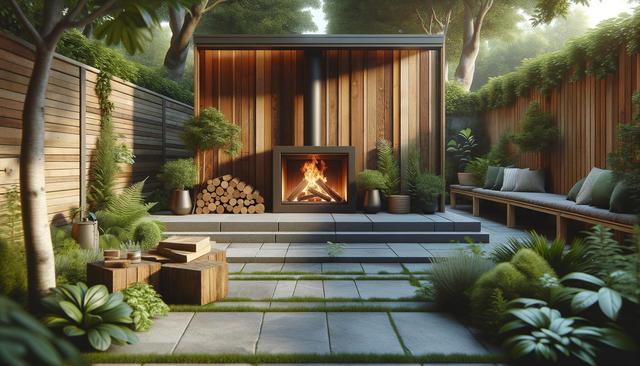The Appeal of a Wood Outdoor Fireplace
Wood outdoor fireplaces have a timeless aesthetic that brings both visual warmth and functional value to any outdoor living area. Unlike gas or electric alternatives, wood-burning fireplaces offer an authentic experience — the crackling sound of logs, the scent of burning wood, and the flickering dance of flames. These elements combine to create a nostalgic and comforting environment that encourages connection and calmness.
In addition to their ambiance, wood outdoor fireplaces can also enhance property value and extend the usefulness of outdoor spaces into cooler seasons. By serving as a natural focal point, they help define outdoor living areas, making patios, decks, or gardens feel more like an extension of the home.
Whether you’re hosting a social gathering or enjoying a quiet evening under the stars, a wood outdoor fireplace provides a unique and organic charm that’s hard to replicate with other heating options.
Design Considerations for Your Outdoor Space
When planning to add a wood outdoor fireplace, design plays a central role in ensuring it complements your outdoor setting. Start by identifying the purpose of the space — whether it’s for casual family evenings, entertaining guests, or simply adding a decorative element. From there, key factors to consider include:
- Location: Ensure the fireplace is placed away from flammable structures and in compliance with local codes.
- Materials: Natural stone, brick, and stucco are popular choices that offer durability and blend well with most landscapes.
- Size: The scale of the fireplace should match the size of your outdoor area to maintain balance and proportion.
Additionally, integrating built-in seating, storage for logs, or even cooking features like a grill or pizza oven can enhance functionality. The goal is to design a space that encourages use and enjoyment throughout the year.
Practical Benefits of Wood Fireplaces Outdoors
Beyond aesthetics, wood outdoor fireplaces offer a range of practical benefits. One of the main advantages is their heating capability. Wood fires generate a significant amount of radiant heat, making them ideal for staying warm during chilly evenings. This can make outdoor spaces usable even in late autumn or early spring, effectively extending the outdoor living season.
Another benefit is cost efficiency. While the initial construction may require investment, the ongoing cost of wood is often lower than gas or electric alternatives, especially for those with easy access to firewood. Additionally, wood fireplaces are not dependent on power sources, which can be a plus during outages or off-grid living scenarios.
Other practical features include:
- Eco-friendliness when using sustainably sourced firewood.
- Low maintenance with proper care and seasonal cleaning.
- The ability to cook directly over the fire, adding a rustic culinary option for outdoor meals.
These functional aspects make wood fireplaces a versatile and valuable addition to many backyards.
Maintenance and Safety Tips
Safety and maintenance are crucial when it comes to enjoying a wood outdoor fireplace responsibly. Regular upkeep not only improves performance but also extends the lifespan of your fireplace. Begin with routine tasks like removing ash buildup, checking for cracks in the masonry, and inspecting the chimney or flue to ensure proper ventilation.
Safety practices should always be a top priority:
- Keep a safe perimeter around the fireplace free of flammable materials.
- Use a spark screen or protective cover to prevent embers from escaping.
- Store firewood at a safe distance and in a dry, covered area.
- Never leave a fire unattended, and keep a fire extinguisher or water source nearby.
Additionally, it’s wise to schedule a professional inspection annually, especially if the fireplace sees frequent use. Following these guidelines will help ensure a safe and enjoyable experience for everyone.
Choosing the Right Wood and Fueling Techniques
Not all wood is created equal when it comes to outdoor fireplaces. Choosing the right type of firewood can significantly impact the quality and safety of your fire. Hardwoods such as oak, maple, and hickory are often preferred due to their long burn times and high heat output. These dense woods produce less creosote, a byproduct that can build up in chimneys and pose a fire risk.
Softwoods like pine or spruce may be easier to ignite but can create more smoke and residue. If used, they should be seasoned properly — meaning dried for at least 6 to 12 months — to reduce moisture content and ensure a clean burn. Here are a few tips for effective fueling:
- Use dry, seasoned wood with a moisture content below 20%.
- Stack logs loosely to allow airflow and encourage steady combustion.
- Avoid burning treated or painted wood, which can release harmful chemicals.
Incorporating proper fueling techniques not only maximizes heat efficiency but also reduces emissions and keeps your fireplace cleaner. Being mindful about what you burn contributes to a safer, more sustainable outdoor experience.
Conclusion: Enhancing Outdoor Living with Natural Warmth
For homeowners seeking to enrich their outdoor living areas, a wood outdoor fireplace offers a compelling blend of style, functionality, and sensory appeal. From cozy nights with family to lively social gatherings, the warmth and ambiance of a wood fire can transform an ordinary backyard into a cherished retreat. With thoughtful design, proper maintenance, and safe fueling practices, this feature can provide lasting enjoyment for years to come. Whether you’re starting from scratch or upgrading an existing space, a wood outdoor fireplace is a rewarding investment in comfort and atmosphere.







